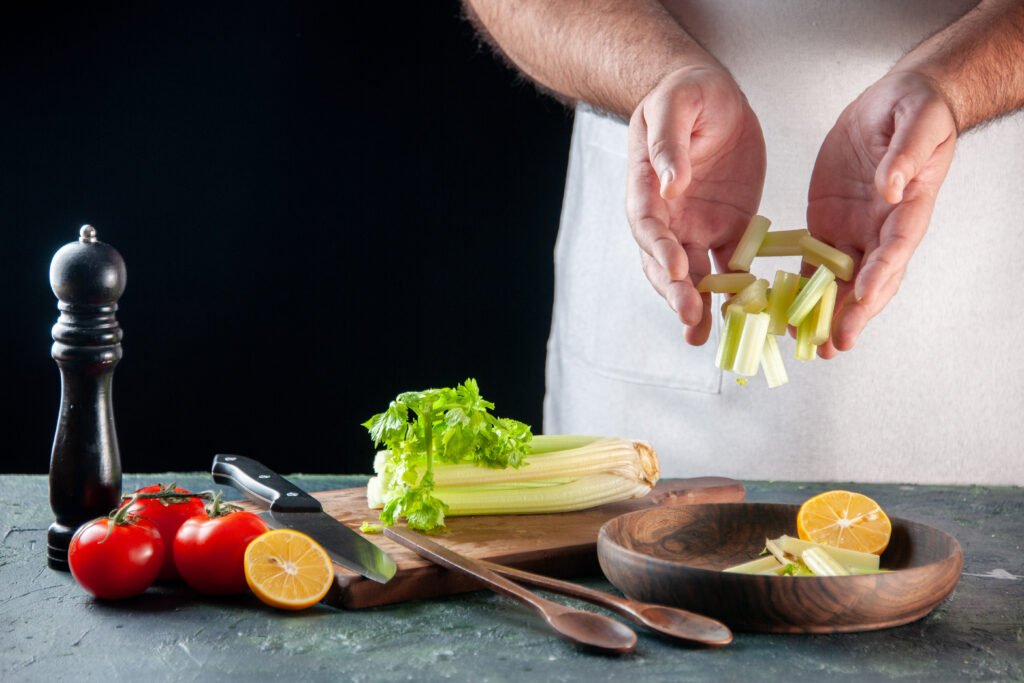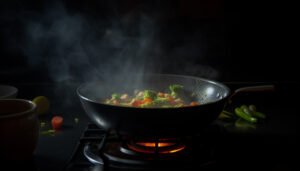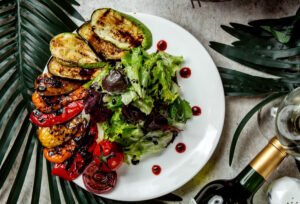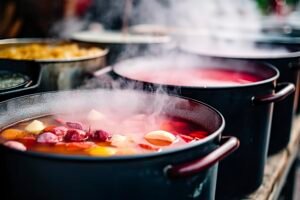Everything to know about the Zero oil cooking

What is zero oil cooking?
Zero oil cooking refers to a method of preparing food without using any oil. This style of cooking aims to promote healthier eating habits by eliminating added fats from oils, which are high in calories and can contribute to various health issues when consumed in excess, such as obesity, heart disease, and high cholesterol. Zero oil cooking techniques include boiling, steaming, baking, grilling, and sautéing with water, broth, or tomato juice as alternatives to oil.
The concept is popular among those following heart-healthy diets, weight loss programs, and anyone interested in reducing their fat intake for health reasons. It encourages the consumption of whole, unprocessed foods and emphasizes the importance of flavour from natural ingredients like herbs, spices, and aromatic vegetables instead of relying on fats for taste.
There are 5 different kind of Zero oil cooking.
- Steaming: Cooking food with steam retains moisture without the need for oil.
Yes, steaming is a popular method used in zero oil cooking. It involves cooking food using the steam from boiling water. This method is highly effective for cooking a wide range of foods, including vegetables, fish, and even some types of breads and dumplings. Since the food is cooked by steam, there is no need to add oil, making it a healthier cooking option.
Steaming helps in retaining the natural flavours and nutrients of the food, which can often be lost through other cooking methods that rely on high heat or added fats. Moreover, it’s a simple and quick way to prepare meals, requiring minimal equipment beyond a steamer basket or a pot with a lid.

- Boiling: Food is cooked in water or broth, which doesn’t require oil.
Yes, boiling is another method used in zero oil cooking. It involves cooking food by immersing it in water or broth, which is then brought to a boil. This method is suitable for a variety of foods, including vegetables, grains (like rice and pasta), legumes (such as beans and lentils), and meats. Boiling is a straightforward technique that doesn’t require oil, making it a healthier option for preparing meals.
Boiling can help in softening food and making it easier to digest. However, it’s important to note that some nutrients, particularly water-soluble vitamins like vitamin C and some B vitamins can leach out into the cooking water during boiling. To minimize nutrient loss, you can use as little water as possible or repurpose the cooking liquid in soups and sauces to retain the nutrients that have leached out.
Boiling is a versatile cooking method that can be easily adapted for a wide range of ingredients, making it a staple in zero oil cooking practices.
- Baking or Roasting: Using parchment paper, silicone mats, or glassware can allow food to be baked or roasted without oil.
Yes, baking or roasting without oil is entirely feasible and often employed in zero oil cooking strategies. By using alternatives like parchment paper, silicone baking mats, or non-stick glassware, you can effectively bake or roast foods without the need for oil. These materials prevent the food from sticking to the cooking surfaces, eliminating the need for oil as a lubricant.
Parchment paper, for instance, provides a non-stick surface that can withstand high oven temperatures, making it ideal for baking goods like cookies, vegetables, and even fish. Silicone baking mats offer a reusable option with similar non-stick properties, suitable for a wide range of baking and roasting needs. Glassware, particularly when used for baking casseroles or roasting vegetables, can also minimize sticking due to its smooth surface, especially if the food contains some moisture.
These methods not only reduce the fat content of the food but also simplify cleanup. Foods cooked this way can still turn out to be deliciously crisp and browned, depending on the cooking technique and the oven’s temperature, proving that healthy cooking doesn’t have to compromise on texture or flavour.

- Grilling: Grilling can impart a lot of flavours without the need for added fats, though care must be taken to prevent sticking.
Yes, grilling is another excellent method for zero oil cooking that can infuse foods with a rich, smoky flavour without the need for added fats. The high heat from the grill chars the surface of the food, creating a complex flavour profile and appealing texture. Grilled vegetables, meats, and fish are popular for their distinctive taste and health benefits, as grilling requires no additional fat and can actually reduce the fat content of some meats as it drips away during the cooking process.
However, to ensure success with grilling and to prevent food from sticking to the grill grates, a few precautions are necessary:
- Preheat the Grill: Make sure the grill is properly heated before adding your food. A hot grill helps to sear the food quickly, reducing the chances of sticking.
- Clean Grill Grates: Always start with a clean grill. Food residues from previous grilling can cause sticking. A stiff wire brush can be used to clean the grates after preheating.
- Create a Non-Stick Surface: Although you’re avoiding oil, you can still lightly brush the food itself with a minimal amount of oil or use a marinade to help prevent sticking.
- For a completely oil-free option, consider using a grill mat or foil with perforations that allow the smoke to reach the food while preventing it from sticking directly to the grates.
- Don’t Flip Too Early: Give food enough time to sear and naturally release from the grill grates before flipping. If you try to turn it too soon, it may stick and tear.
By taking these steps, you can enjoy the flavourful benefits of grilling without needing to rely on added fats, making it a great option for healthy, zero oil cooking.

- Sautéing or Stir-frying: A small amount of water, broth, vinegar, or soy sauce can be used instead of oil to cook vegetables or meats over high heat.
Yes, sautéing or stir-frying without oil is possible and can be a healthy cooking technique, aligning with the principles of zero oil cooking. Typically, these methods involve cooking food quickly over high heat with a small amount of fat. However, by substituting oil with alternatives like water, broth, vinegar, or soy sauce, you can still achieve delicious results while reducing the fat content.
Here’s how to adapt these methods for zero oil cooking:
- Use a Non-Stick Pan or Wok: Start with a good-quality non-stick pan or wok to prevent food from sticking to the surface. This is especially important when not using oil.
- Choose Your Liquid: Depending on the recipe and desired flavour profile, you can use water, vegetable broth, vinegar, soy sauce, or a combination of these liquids as your cooking medium. These liquids will help to cook and soften the food while adding flavour.
- Heat the Pan: Preheat your pan on medium to high heat. If using water or broth, wait until it’s hot but not evaporating too quickly before adding your ingredients.
- Add Ingredients Strategically: If you’re cooking a mix of ingredients, add those that take longer to cook first, and then add quicker-cooking ingredients towards the end. Since there’s no oil to coat the ingredients, stirring frequently is crucial to ensure even cooking and prevent sticking.
- Adjust Liquid as Needed: Keep a small cup of your cooking liquid handy to add a little at a time as it evaporates, to keep the food from sticking and to help in cooking.
- Flavour Development: While you might miss the flavour that oil can impart, using ingredients like garlic, onions, spices, and herbs can help build depth and richness in your dish.
This method of cooking not only reduces the calorie and fat content of your meals but also maintains the nutritional integrity of your ingredients by cooking them quickly and at high heat. It’s a versatile technique that can be applied to a wide variety of ingredients and cuisines, making it a valuable skill for healthy cooking.

- Air frying: Air fryers cook food by circulating hot air around it, achieving a crispy texture similar to frying without the need for oil.
Yes, air frying is a popular cooking method that offers a healthier alternative to traditional deep-frying by significantly reducing the amount of oil needed to achieve a similar texture and taste. Air fryers work by circulating hot air around the food at high speed, using a technology similar to convection ovens. This rapid air circulation cooks the food from all sides at once, creating a crispy outer layer while keeping the inside cooked evenly and retaining moisture.
Because air fryers require little to no oil, they are an excellent tool for zero oil cooking. Many foods that are typically deep-fried, such as French fries, chicken wings, and vegetable fritters, can be cooked in an air fryer with just a light spray or brushing of oil, or even completely oil-free, depending on the food’s natural fat content and your personal preference.
The benefits of using an air fryer include:
- Reduced Fat Content: Cooking with an air fryer can significantly lower the overall fat content of your meals, making them healthier.
- Fewer Calories: By minimizing oil usage, air-fried foods are generally lower in calories than their deep-fried counterparts.
- Convenience: Air fryers heat up quickly and have relatively short cooking times, making them convenient for quick meals and snacks.
- Safety and Cleanliness: Since there’s no need to work with large quantities of hot oil, air frying is safer and typically results in less mess and odor in the kitchen compared to deep-frying.
While the texture and flavour of air-fried foods are remarkably similar to deep-fried foods, it’s worth noting that the results might not be identical, as the lack of oil can affect the final outcome. However, many find the differences minimal and well worth the health benefits that come with reducing oil consumption.
Zero oil cooking involves preparing food without the use of added fats or oils, relying instead on alternative cooking techniques and liquids to cook and flavour food. Here are some popular methods and strategies for zero oil cooking:

- Steaming
Steaming cooks food using the steam from boiling water. It’s excellent for vegetables, fish, and even some desserts. This method preserves nutrients and natural flavors without the need for oil.
- Boiling
Boiling involves cooking food directly in water or broth until it’s tender. It’s a simple method suitable for grains, legumes, vegetables, and more. Flavorful broths can add extra taste without the need for oil.
- Baking or Roasting
By using non-stick cookware, silicone baking mats, or parchment paper, you can bake or roast food in the oven without oil. Vegetables, meats, and fish can be cooked this way, often with added herbs and spices for flavour.
- Grilling
Grilling provides a smoky flavor to food without needing oil. Using a non-stick grill pan or prepping the food so it doesn’t stick (e.g., marinating or using a grill basket) can prevent food from sticking to the grill grates.
- Air Frying
Air fryers use hot air to cook food, creating a crispy texture similar to frying but with little to no oil. It’s suitable for a wide range of foods, including vegetables, meats, and even baked goods.
- Sautéing or Stir-frying
Instead of oil, use a small amount of water, broth, or a flavorful liquid like soy sauce or vinegar to cook and soften vegetables and meats over high heat. Use a non-stick pan to prevent sticking.
- Poaching
Poaching is gently cooking food by submerging it in a simmering liquid, typically water, broth, or milk. It’s especially good for eggs, fish, and fruit, yielding tender and moist results.
- Braising or Stewing
These methods involve cooking ingredients slowly in a covered pot with a small amount of liquid. They’re great for developing deep flavours in dishes like soups, stews, and casseroles, without the need for added fats.
- Pressure Cooking
Using a pressure cooker can speed up the cooking process of many dishes that would typically require oil, using steam pressure to cook food quickly while retaining moisture and flavour.

Easy tips to cooking without oil.
Cooking without oil can be a simple and rewarding approach to preparing healthier meals. Here are some easy tips to help you cook without oils and still enjoy delicious, flavorful food:
- Use Non-Stick Cookware
Invest in good quality non-stick pans, pots, and baking sheets to prevent food from sticking without the need for oil. Ceramic, hard-anodized, and silicone cookware are excellent choices.
- Explore Cooking Methods That Don’t Require Oil
Experiment with cooking methods such as steaming, boiling, baking, roasting, grilling, air frying, and poaching, which don’t rely on oil to cook food effectively.
- Utilize Broths and Stocks
Instead of sautéing with oil, use vegetable broth, chicken stock, or water to cook your vegetables, meats, or stir-fries. Add a little at a time to prevent sticking and to add flavor.
- Embrace Marinades and Spices
Marinate meats and vegetables in vinegar, lemon juice, herbs, and spices to infuse them with flavour before cooking. You can also use these ingredients to season your food during cooking.
- Try Parchment Paper or Silicone Mats for Baking
When baking or roasting, line your pans with parchment paper or a silicone baking mat to prevent sticking without the need for oil.
- Use Silicone Brushes or Spray Bottles
If you need just a touch of moisture, fill a spray bottle with water, broth, or a mix of water and soy sauce, and lightly spray your food. You can also use a silicone brush to apply a minimal amount of liquid.
- Rely on the Food’s Natural Fats
Some foods, like fatty fish, dark meat poultry, or certain cuts of meat, have enough natural fats that will render out and help in the cooking process, minimizing the need for added oils.
- Wrap and Cook
Utilize aluminium foil or parchment paper to wrap and cook food, trapping moisture and flavor inside. This is great for baking or grilling vegetables, fish, and lean meats.
- Get Creative with Flavourings
Intensify flavours without fat by using a variety of herbs, spices, citrus zest, and flavoured vinegars. These can add depth and complexity to your dishes.
- Be Patient and Experiment
Zero oil cooking may require some adjustments and experimentation to get right, especially when learning how to prevent sticking and achieve the desired flavours. Be patient and don’t be afraid to try different techniques and seasonings.
By incorporating these tips into your cooking routine, you can enjoy a wide range of healthy, flavourful dishes without the need for added oils.
Adopting zero oil cooking methods can be a healthy way to prepare meals, reducing fat and calorie intake while still enjoying a variety of delicious and nutritious dishes.

Benefits of Zero cooking oil
Zero oil cooking offers a variety of health benefits, making it an attractive option for those looking to improve their diet, manage weight, or address specific health concerns. Here are some of the key benefits:
- Reduced Caloric Intake: Oil is very high in calories, with about 120 calories per tablespoon, regardless of whether it’s olive oil, coconut oil, or any other type. By eliminating oil, you significantly reduce the calorie content of your meals, which can help in weight management or weight loss.
- Lower Fat Consumption: Reducing oil intake also lowers your consumption of fats, particularly saturated and trans fats found in some cooking oils, which can be beneficial for heart health. While some oils contain healthy fats, consuming them in large quantities can still contribute to weight gain and other health issues.
- Improved Heart Health: Zero oil cooking contributes to lower intake of saturated and trans fats, reducing the risk of heart disease. It can help in lowering bad cholesterol levels (LDL) and increasing good cholesterol levels (HDL), improving overall cardiovascular health.
- Better Blood Sugar Control: High-fat diets can impact insulin sensitivity, so reducing fat intake through zero oil cooking can help in managing blood sugar levels, particularly beneficial for people with diabetes or insulin resistance.
- Enhanced Digestive Health: High-fat foods can be heavy and hard to digest, leading to discomfort for some people. Cooking without oil can make meals lighter and easier on the digestive system.
- Nutrient Retention: Some cooking methods that use oil, such as deep frying, can lead to a loss of important nutrients in food. Zero oil cooking methods like steaming, boiling, and baking can help retain more vitamins and minerals.
- Risk Reduction for Certain Diseases: A diet low in fat and calories, facilitated by zero oil cooking, can help reduce the risk of developing several chronic diseases, including obesity, type 2 diabetes, and certain types of cancer.
- Environmental Benefits: Reducing oil usage can also have a positive impact on the environment. The production, packaging, and transportation of cooking oils consume resources and generate pollution. By minimizing oil use, you’re also contributing to a reduction in environmental footprint.
It’s important to note that while zero oil cooking has many benefits; fats are still an essential part of a balanced diet, as they play a crucial role in nutrient absorption and brain health, among other functions. Therefore, it’s beneficial to include sources of healthy fats, such as avocados, nuts, seeds, and fatty fish, in your diet, even if you choose to reduce or eliminate added oils in cooking.
